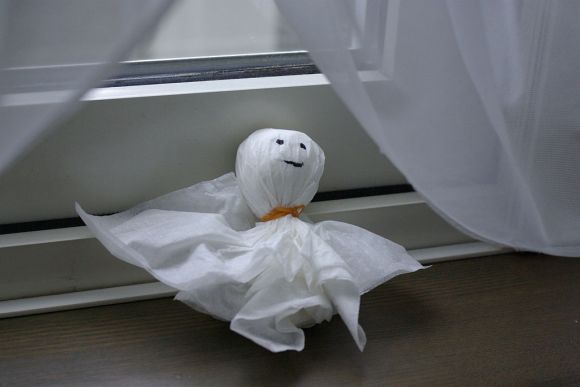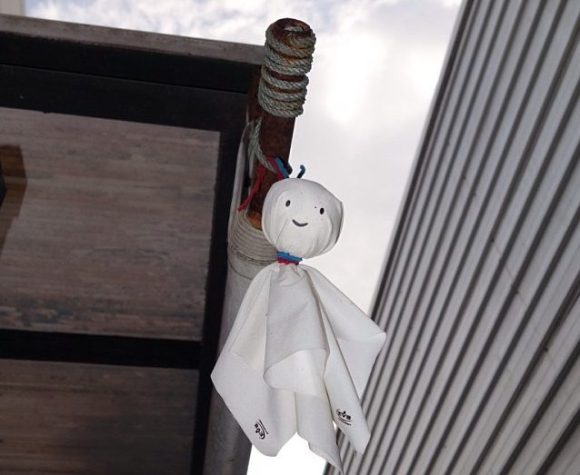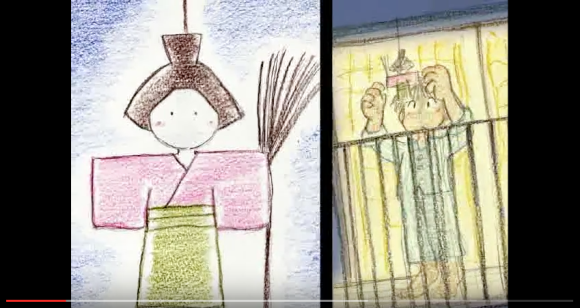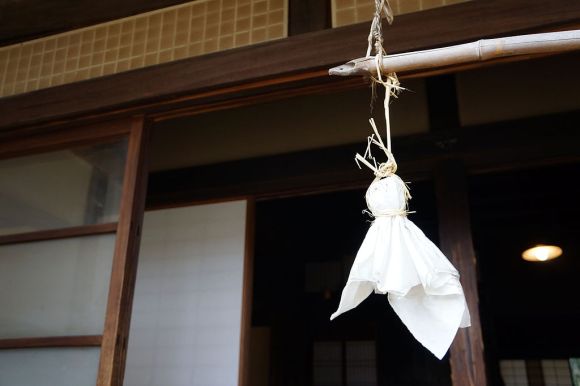
While many believe the tradition of making the ghost-like doll can be traced back to a bald-headed monk, history suggests it actually began with a small girl.
In Japan, children are taught from an early age about the wondrous powers of the teru teru bozu, which translates to shiny baldhead (monk). Easily made from two squares of tissue or cloth, the doll is said to represent a monk’s bald head, and is made when fine weather, which would make its head shiny, is desired the following day. While the tradition is well-practiced and well-known, many Japanese people remain unsure of the origins of the doll; seeing it instead as something they’ve simply been taught to do when good weather is required, ahead of events like sports days, ceremonies and special celebrations.
▼ Traditionally, if the wish for clear skies was granted, the doll was rewarded with drawn-on eyes and a dousing of holy sake and then sent down the river to be washed away.
Hung under the eaves of the house, the teru teru bozu even has an accompanying song, usually sung by children as the doll is being made, acting as a chant to invoke sunny skies the following day. The lyrics to the song, which was released in 1921, actually give us some clues to the doll’s origins and history. The three verses can be translated as:
Teru-teru-bozu, teru bozu/ Do make tomorrow a sunny day/ Like the sky in a dream sometime/If it’s sunny I’ll give you a golden bell
Teru-teru-bozu, teru bozu/ Do make tomorrow a sunny day/ If you make my wish come true/ We’ll drink lots of sweet rice wine
Teru-teru-bozu, teru bozu/ Do make tomorrow a sunny day/ But if the clouds are crying/ Then I shall snip your head off
The origins of the teru teru bozu talisman remain vague, with some saying the dark lyrics towards the end of the popular song refer to a “Good Weather Monk”, who was able to bring fine weather with an incantation. However, after promising good weather to a feudal lord, the sunshine did not appear as promised and the monk’s head was chopped off as punishment. It’s said the monk’s head was then wrapped in cloth and hung outside to stop the rain and bring out the sun.
A less horrifying theory suggests the talisman represents a yokai spirit from the mountains called Hiyoribo, who brings fine weather and can’t be seen on rainy days.
According to the Japan Weather Association, which runs the country’s popular tenki.jp weather app, the tradition of teru teru bozu spread to Japan from China during the Heian Period (794-1185) and can be traced back to a custom that suggests the person charged with invoking good weather was not a monk but a broom-carrying girl.
As the story goes, during a time of heavy and continuous rainfall, a voice from the heavens warned the people that their city would be submerged if a certain beautiful young girl did not appear outside. To save people from the deluge, the girl was essentially sacrificed, sent outside with a broom to symbolically head to the heavens where she would sweep rain clouds from the sky. In order to remember the brave girl who brought clear skies, young ladies would recreate her figure in paper cut-outs, a skill in which the broom-carrying girl once excelled. These figures were then hung outside to bring sunshine in times of rain.
Known as 掃晴娘 (So-Chin-Nyan) or Souseijou in Japanese, which literally means “sweeping fine weather girl”, the paper doll concept gradually took on a different face in Japan, eventually becoming the teru teru bozu we see today. This theory, which has the support of folk historians, sheds light on the origins of the weather talisman, which, with the rainy season still well underway, will be popping up outside windows and under rooftops around the country.
If you’d like to see the broom-carrying fine weather girl in action, check out the animated short below.
Source: Spotlight
Top Image:Wikimedia Commons/Jun OHWADA
Insert Images: Wikimedia Commons/Keng Susumpow, Wikimedia Commons, Wikimedia Commons, Wikimedia Commons/Kentaro Ohno, Youtube/zqdym
Follow Oona on Twitter for more news on traditional Japanese culture and customs.






 Japanese Shiba Inu shows even the dog world’s biggest goofs can have elegant table manners【Video】
Japanese Shiba Inu shows even the dog world’s biggest goofs can have elegant table manners【Video】 Weathering with You anime cafe opening soon with beautiful Shinkai-inspired menu items【Photos】
Weathering with You anime cafe opening soon with beautiful Shinkai-inspired menu items【Photos】 Kana Hanazawa doesn’t understand her latest commercial 【Video】
Kana Hanazawa doesn’t understand her latest commercial 【Video】 There’s a Makoto Shinkai anime-inspired tea in Japan, and it’s beautiful like his films
There’s a Makoto Shinkai anime-inspired tea in Japan, and it’s beautiful like his films Check the weather forecast with a cool gadget that recreates the conditions in your living room
Check the weather forecast with a cool gadget that recreates the conditions in your living room Japan’s new difficult-to-drink-from beer glass protects your liver, but it’s a brutal experience
Japan’s new difficult-to-drink-from beer glass protects your liver, but it’s a brutal experience Hello, cosmetics! Clinique teams up with Hello Kitty this summer for first-time collaboration
Hello, cosmetics! Clinique teams up with Hello Kitty this summer for first-time collaboration How to order snacks on a Shinkansen bullet train in Japan
How to order snacks on a Shinkansen bullet train in Japan Demon Slayer: Kimetsu no Yaiba gets new roller coaster attractions and food at Universal Studios Japan
Demon Slayer: Kimetsu no Yaiba gets new roller coaster attractions and food at Universal Studios Japan New samurai glasses are Japan’s latest weird must-have souvenir
New samurai glasses are Japan’s latest weird must-have souvenir Burger King Japan suddenly adds Dr. Pepper and Dr. Pepper floats to its menu nationwide
Burger King Japan suddenly adds Dr. Pepper and Dr. Pepper floats to its menu nationwide New Nintendo Lego kit is a beautiful piece of moving pixel art of Mario and Yoshi【Photos】
New Nintendo Lego kit is a beautiful piece of moving pixel art of Mario and Yoshi【Photos】 What do you eat when you catch a cold? We asked 11 of our Japanese reporters
What do you eat when you catch a cold? We asked 11 of our Japanese reporters High-fashion Totoro cuddle purse is like an elegant stroll in the forest【Photos】
High-fashion Totoro cuddle purse is like an elegant stroll in the forest【Photos】 Why Japanese doesn’t need swear words
Why Japanese doesn’t need swear words Nintendo history you can feel – Super NES, N64, and GameCube controllers become capsule toys
Nintendo history you can feel – Super NES, N64, and GameCube controllers become capsule toys “The most Delicious Cup Noodle in history” – Japan’s French Cup Noodle wins our heart【Taste test】
“The most Delicious Cup Noodle in history” – Japan’s French Cup Noodle wins our heart【Taste test】 Starbucks releases a cute Frappuccino and Unicorn Cake…but not in Japan
Starbucks releases a cute Frappuccino and Unicorn Cake…but not in Japan Kyoto Tower mascot termination reveals dark side behind cute Japanese characters
Kyoto Tower mascot termination reveals dark side behind cute Japanese characters McDonald’s Japan’s Soft Twist Tower: A phantom ice cream only sold at select branches
McDonald’s Japan’s Soft Twist Tower: A phantom ice cream only sold at select branches Yabai Ramen: What makes this Japanese ramen so dangerous?
Yabai Ramen: What makes this Japanese ramen so dangerous? Finally! Nintendo Japan expands Switch 8-bit controller sales to everybody, Online member or not
Finally! Nintendo Japan expands Switch 8-bit controller sales to everybody, Online member or not Japanese government wants to build luxury resorts in all national parks for foreign tourists
Japanese government wants to build luxury resorts in all national parks for foreign tourists To combat declining birth rate, Japan to begin offering “Breeding Visas” to foreigners
To combat declining birth rate, Japan to begin offering “Breeding Visas” to foreigners 10 things you should buy at 7-Eleven in Japan
10 things you should buy at 7-Eleven in Japan Studio Ghibli releases anime heroine cosplay dresses that are super comfy to wear
Studio Ghibli releases anime heroine cosplay dresses that are super comfy to wear Woman charged for driving suitcase without a license in Osaka
Woman charged for driving suitcase without a license in Osaka Studio Ghibli unveils My Neighbour Totoro miniature house model
Studio Ghibli unveils My Neighbour Totoro miniature house model Kyoto experiencing problems with foreign tourists not paying for bus fares, but not on purpose
Kyoto experiencing problems with foreign tourists not paying for bus fares, but not on purpose Fighting mild hunger with a Japanese soda that turns into jelly in the stomach【Taste test】
Fighting mild hunger with a Japanese soda that turns into jelly in the stomach【Taste test】 Studio Ghibli’s Howl’s Moving Castle tapestry unveiled in Japan for first time
Studio Ghibli’s Howl’s Moving Castle tapestry unveiled in Japan for first time McDonald’s new Happy Meals offer up cute and practical Sanrio lifestyle goods
McDonald’s new Happy Meals offer up cute and practical Sanrio lifestyle goods Sales of Japan’s most convenient train ticket/shopping payment cards suspended indefinitely
Sales of Japan’s most convenient train ticket/shopping payment cards suspended indefinitely Sold-out Studio Ghibli desktop humidifiers are back so Totoro can help you through the dry season
Sold-out Studio Ghibli desktop humidifiers are back so Totoro can help you through the dry season Japanese government to make first change to romanization spelling rules since the 1950s
Japanese government to make first change to romanization spelling rules since the 1950s Foreigner’s request for help in Tokyo makes us sad for the state of society
Foreigner’s request for help in Tokyo makes us sad for the state of society Ghibli founders Toshio Suzuki and Hayao Miyazaki contribute to Japanese whisky Totoro label design
Ghibli founders Toshio Suzuki and Hayao Miyazaki contribute to Japanese whisky Totoro label design Doraemon found buried at sea as scene from 1993 anime becomes real life【Photos】
Doraemon found buried at sea as scene from 1993 anime becomes real life【Photos】 Tokyo’s most famous Starbucks is closed
Tokyo’s most famous Starbucks is closed Princesses, fruits, and blacksmiths: Study reveals the 30 most unusual family names in Japan
Princesses, fruits, and blacksmiths: Study reveals the 30 most unusual family names in Japan The best cosplayers from Day Two of the Ikebukuro Halloween Cosplay Festival
The best cosplayers from Day Two of the Ikebukuro Halloween Cosplay Festival Do you really need to wear toilet slippers when using the bathroom at home? Japan’s netizens vote
Do you really need to wear toilet slippers when using the bathroom at home? Japan’s netizens vote Weathering with You anime exhibition coming to Tokyo with special cafe menu items
Weathering with You anime exhibition coming to Tokyo with special cafe menu items 15 million flowers are in beautiful bloom right now at Saitama’s field of Heavenly Poppies
15 million flowers are in beautiful bloom right now at Saitama’s field of Heavenly Poppies Woman in short skirt arrested after inciting upskirt photography in Tokyo
Woman in short skirt arrested after inciting upskirt photography in Tokyo Rainy day in Kyoto creates amazing photo of sakura above, below, and all around
Rainy day in Kyoto creates amazing photo of sakura above, below, and all around Gray-sky Gundam photo will brighten the hearts of anyone who loves anime or awesomeness
Gray-sky Gundam photo will brighten the hearts of anyone who loves anime or awesomeness Gigantic lightning-spitting thundercloud appears in the skies over Tokyo【Videos】
Gigantic lightning-spitting thundercloud appears in the skies over Tokyo【Videos】 Solar Chef: We tried cooking an egg using the power of the sun and a magnifying glass
Solar Chef: We tried cooking an egg using the power of the sun and a magnifying glass Summer in Japan doesn’t feel like a Japanese summer this year, many are saying
Summer in Japan doesn’t feel like a Japanese summer this year, many are saying All the cutest, fluffy bunnies of Twitter are here to bring some cheer to your week
All the cutest, fluffy bunnies of Twitter are here to bring some cheer to your week Japan’s Raincoat Man arrested for stealing 360 women’s raincoats, “As exciting as lingerie”【Vids】
Japan’s Raincoat Man arrested for stealing 360 women’s raincoats, “As exciting as lingerie”【Vids】 Hydrophobic umbrellas are here to prevent sogginess during Japan’s infamous rainy season
Hydrophobic umbrellas are here to prevent sogginess during Japan’s infamous rainy season New Studio Ghibli Spirited Away merchandise: Golden amulets tell fortunes from No Face’s belly
New Studio Ghibli Spirited Away merchandise: Golden amulets tell fortunes from No Face’s belly Tokyo Disney’s first fashion dolls make their debut!
Tokyo Disney’s first fashion dolls make their debut!
Leave a Reply